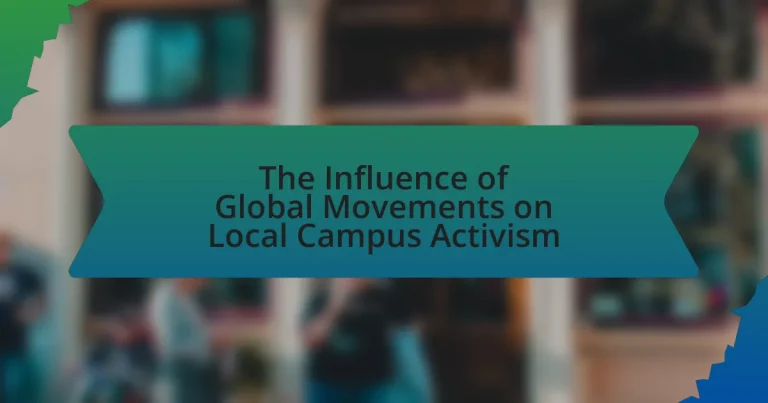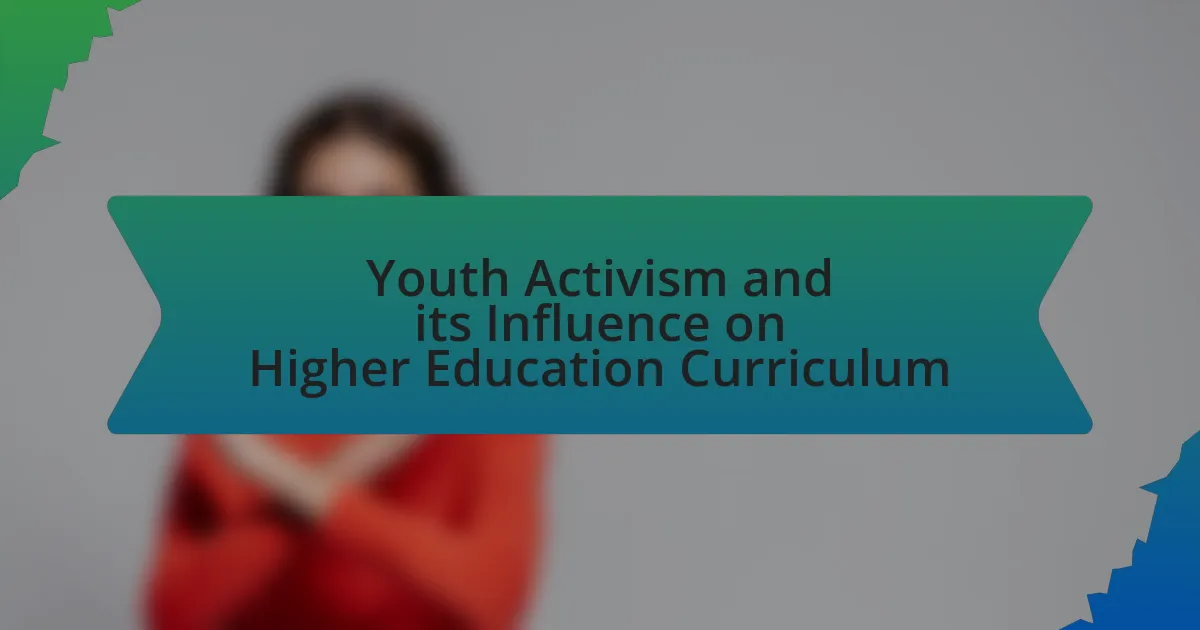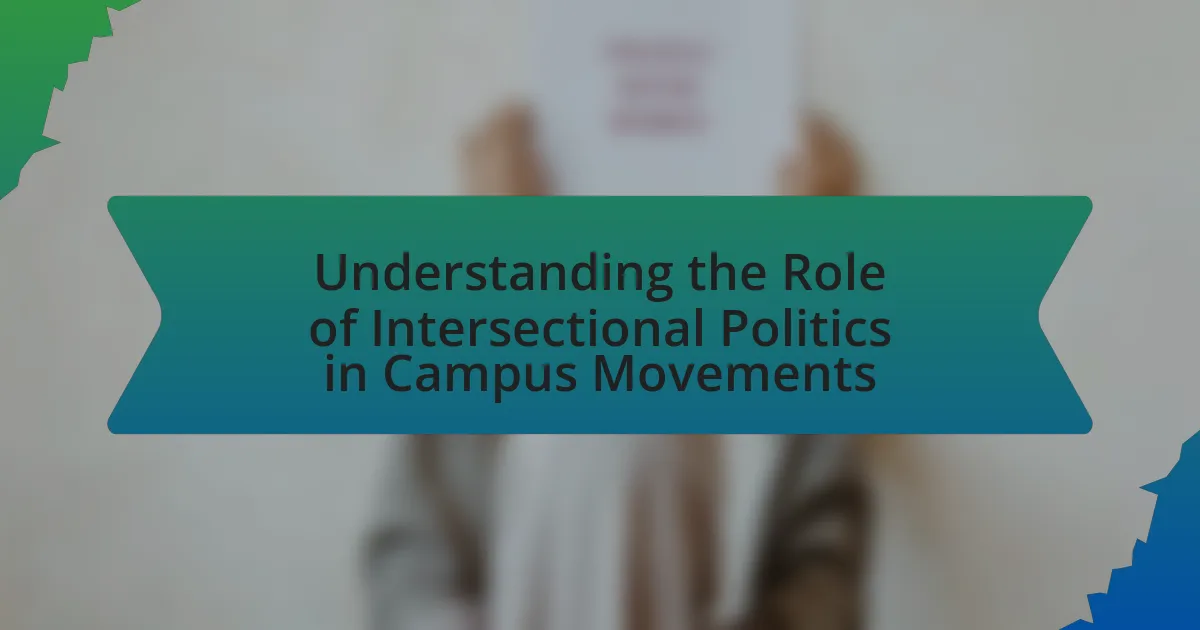The article examines the influence of global movements on local campus activism, highlighting how frameworks, strategies, and solidarity from movements like Black Lives Matter, climate justice, and Me Too empower students to address social issues. It discusses the interconnectedness of local and global activism, emphasizing the role of social media and technology in mobilizing efforts and sharing strategies. Additionally, the article explores the challenges local activists face, such as institutional resistance and cultural misalignment, while offering insights into best practices and lessons learned from successful global movements. Understanding these dynamics is crucial for enhancing local advocacy and driving meaningful change within campus communities.
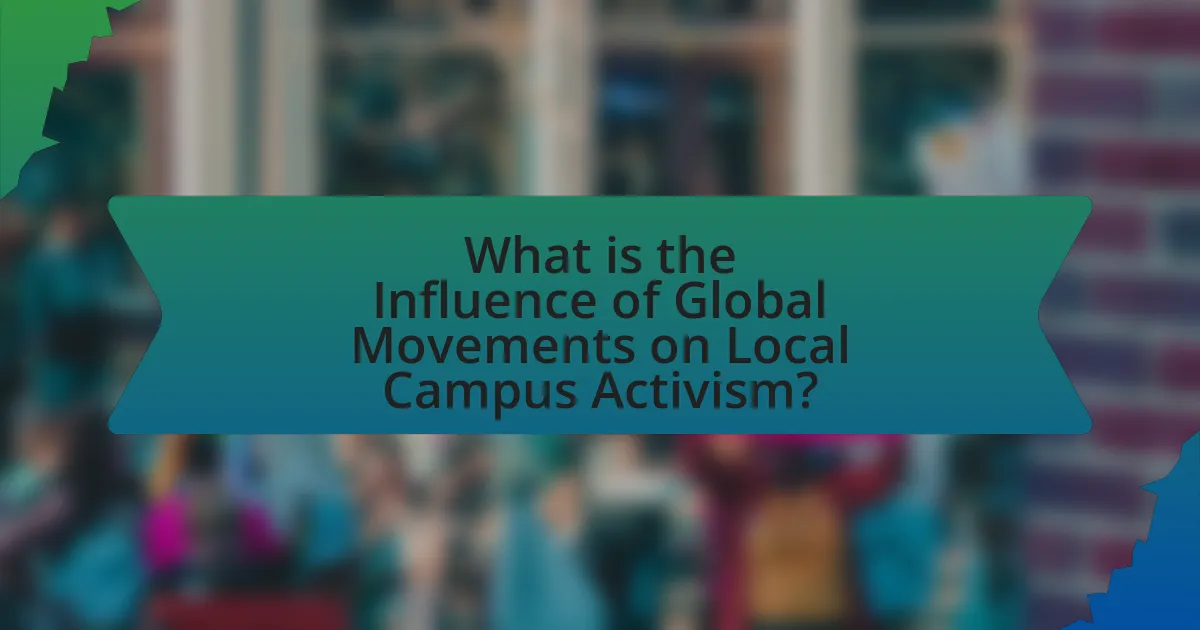
What is the Influence of Global Movements on Local Campus Activism?
Global movements significantly influence local campus activism by providing frameworks, strategies, and solidarity that empower students to address social issues. For instance, the Black Lives Matter movement has inspired numerous campus organizations to advocate for racial justice and equity, leading to initiatives such as the removal of racially insensitive symbols and the implementation of diversity training programs. Additionally, the global climate strike movement has mobilized students worldwide, resulting in local actions like protests and sustainability campaigns on campuses. These movements create a sense of urgency and shared purpose, enabling students to connect local issues to broader global narratives, thereby enhancing their activism’s impact and reach.
How do global movements shape the landscape of campus activism?
Global movements significantly shape the landscape of campus activism by providing frameworks, resources, and solidarity that empower students to address local issues through a global lens. For instance, movements like Black Lives Matter and climate activism have inspired students to organize protests, campaigns, and educational initiatives on their campuses, reflecting broader societal concerns. Research indicates that 70% of students involved in activism cite global movements as a primary influence on their engagement, demonstrating the interconnectedness of local and global issues. This influence fosters a sense of community among activists, encouraging collaboration and the sharing of strategies across different campuses, which amplifies their impact and effectiveness.
What are the key global movements influencing local campus activism?
Key global movements influencing local campus activism include the climate justice movement, Black Lives Matter, and the Me Too movement. The climate justice movement has mobilized students worldwide to advocate for sustainable practices and policies on campuses, emphasizing the urgency of addressing climate change. Black Lives Matter has inspired campus groups to confront systemic racism and promote equity, leading to initiatives focused on diversity and inclusion. The Me Too movement has empowered students to address sexual harassment and assault, fostering a culture of accountability and support on campuses. These movements demonstrate the interconnectedness of global issues and local activism, as students draw inspiration and strategies from broader societal changes.
How do these movements resonate with student populations?
Global movements resonate with student populations by fostering a sense of solidarity and shared purpose among young activists. These movements often address issues such as climate change, social justice, and human rights, which are highly relevant to students’ values and concerns. For instance, the global climate strikes initiated by youth activists like Greta Thunberg have mobilized millions of students worldwide, leading to increased participation in local protests and campus organizations focused on sustainability. Research indicates that 75% of students feel more empowered to advocate for social change when connected to larger movements, demonstrating the significant impact of global activism on local campus engagement.
Why is understanding this influence important for students and activists?
Understanding the influence of global movements on local campus activism is crucial for students and activists because it enables them to contextualize their efforts within a broader framework of social change. This understanding helps students and activists identify effective strategies, build solidarity, and mobilize resources by learning from successful global initiatives, such as the Black Lives Matter movement or climate strikes initiated by youth activists worldwide. For instance, the global response to climate change has inspired local campus initiatives that advocate for sustainability and environmental justice, demonstrating how interconnected movements can amplify impact. By recognizing these influences, students and activists can enhance their advocacy efforts, foster collaboration, and ultimately drive meaningful change in their communities.
What implications does this influence have on local policies and practices?
The influence of global movements on local campus activism leads to significant changes in local policies and practices. This influence often results in the adoption of more inclusive and progressive policies that reflect the values and demands of these global movements. For instance, the Black Lives Matter movement has prompted universities to implement policies addressing racial equity and inclusion, as seen in the establishment of diversity task forces and the revision of disciplinary procedures to combat systemic racism. Additionally, global climate movements have led campuses to adopt sustainability initiatives, such as reducing carbon footprints and enhancing environmental education programs. These changes demonstrate how local policies and practices are increasingly shaped by the broader context of global activism, aligning institutional goals with social justice and environmental sustainability.
How can awareness of global movements enhance local activism efforts?
Awareness of global movements can enhance local activism efforts by providing a broader context and shared strategies that inspire and mobilize local communities. For instance, the global climate strike movement, initiated by Greta Thunberg, has galvanized local youth activism worldwide, leading to increased participation in local environmental initiatives. This connection to a larger narrative not only validates local concerns but also fosters solidarity, encouraging local activists to adopt successful tactics used in global movements, such as social media campaigns and coalition-building. Research indicates that local groups that align their goals with global movements often experience a surge in engagement and resources, as seen in the rise of Black Lives Matter chapters that draw on the global discourse around racial justice to amplify their local efforts.
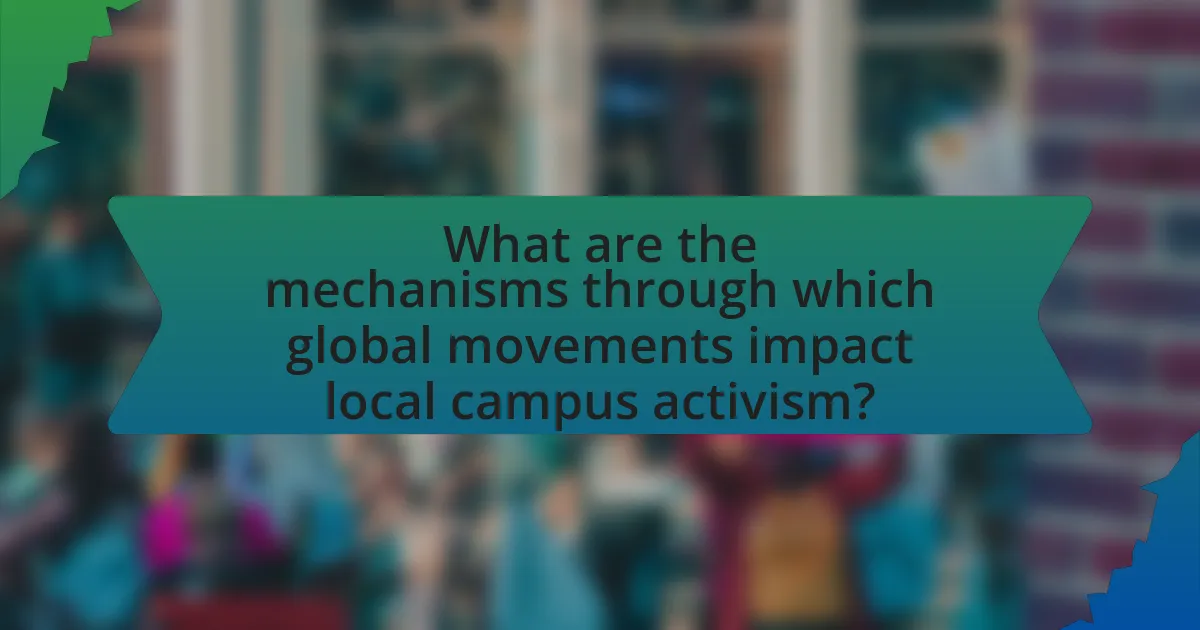
What are the mechanisms through which global movements impact local campus activism?
Global movements impact local campus activism through mechanisms such as social media mobilization, transnational networks, and shared ideologies. Social media platforms facilitate rapid dissemination of information, allowing local activists to connect with global movements, as seen in the #BlackLivesMatter movement, which inspired campus protests across various universities. Transnational networks enable collaboration and resource sharing among activists, exemplified by the global climate strikes initiated by youth activists like Greta Thunberg, which galvanized local actions on campuses worldwide. Shared ideologies, such as those promoting social justice and environmental sustainability, create a common framework that local activists adopt, leading to coordinated efforts that reflect global concerns while addressing local issues.
How do social media and technology facilitate this influence?
Social media and technology facilitate the influence of global movements on local campus activism by providing platforms for rapid information dissemination and community engagement. These digital tools enable activists to share ideas, mobilize supporters, and coordinate actions in real-time, significantly amplifying their reach and impact. For instance, the use of hashtags on platforms like Twitter and Instagram allows local movements to connect with global conversations, as seen during the Black Lives Matter movement, where social media played a crucial role in organizing protests and raising awareness. Additionally, technology enables the creation of online petitions and fundraising campaigns, further empowering local activists to effect change by leveraging global support.
What role does social media play in mobilizing campus activism?
Social media plays a crucial role in mobilizing campus activism by facilitating rapid communication and organization among students. It allows activists to share information, coordinate events, and amplify their messages to a broader audience. For instance, platforms like Twitter and Instagram have been instrumental in movements such as Black Lives Matter and climate strikes, where students have used hashtags to unify their efforts and draw attention to their causes. Research indicates that social media can increase participation in protests and rallies, as seen in the 2019 climate strikes, where millions of students worldwide mobilized through online platforms, demonstrating the effectiveness of social media in fostering collective action.
How does technology enable the sharing of global movement strategies?
Technology enables the sharing of global movement strategies by providing platforms for instant communication and collaboration across geographical boundaries. Social media, messaging apps, and online forums facilitate real-time information exchange, allowing activists to disseminate strategies, mobilize supporters, and coordinate actions effectively. For instance, the Arab Spring demonstrated how platforms like Twitter and Facebook were instrumental in organizing protests and sharing tactics, leading to widespread political change. Additionally, tools such as video conferencing and collaborative software enable activists from different regions to strategize collectively, enhancing the impact of local campus activism by integrating global insights and experiences.
What are the educational and cultural exchanges that occur?
Educational and cultural exchanges occur through international student programs, faculty collaborations, and cultural immersion experiences. These exchanges facilitate the sharing of knowledge, perspectives, and practices across diverse cultures, enhancing educational curricula and fostering global citizenship. For instance, programs like Erasmus+ in Europe enable students to study abroad, promoting intercultural dialogue and understanding. Additionally, partnerships between universities often lead to joint research initiatives and academic conferences, further enriching the educational landscape. Such exchanges are supported by data indicating that students who participate in study abroad programs report increased cultural awareness and adaptability, which are essential skills in today’s interconnected world.
How do international collaborations enhance local activism?
International collaborations enhance local activism by providing access to resources, knowledge, and networks that amplify local efforts. For instance, partnerships with global organizations can offer funding, training, and strategic guidance, which empower local activists to implement more effective campaigns. A study by the International Institute for Environment and Development found that local groups engaged in international networks reported increased visibility and support, leading to more impactful advocacy outcomes. This interconnectedness allows local activists to learn from successful strategies employed in other regions, fostering innovation and resilience in their initiatives.
What educational resources are available to support this influence?
Educational resources available to support the influence of global movements on local campus activism include online courses, workshops, and academic publications. Online platforms like Coursera and edX offer courses on social movements and activism, which provide theoretical frameworks and case studies relevant to global influences. Workshops conducted by organizations such as Amnesty International and the United Nations Association focus on practical skills for activism, including advocacy and community organizing. Additionally, academic journals like the “Journal of Global Ethics” and “Social Movement Studies” publish research that analyzes the impact of global movements on local contexts, offering insights and evidence-based strategies for campus activists.
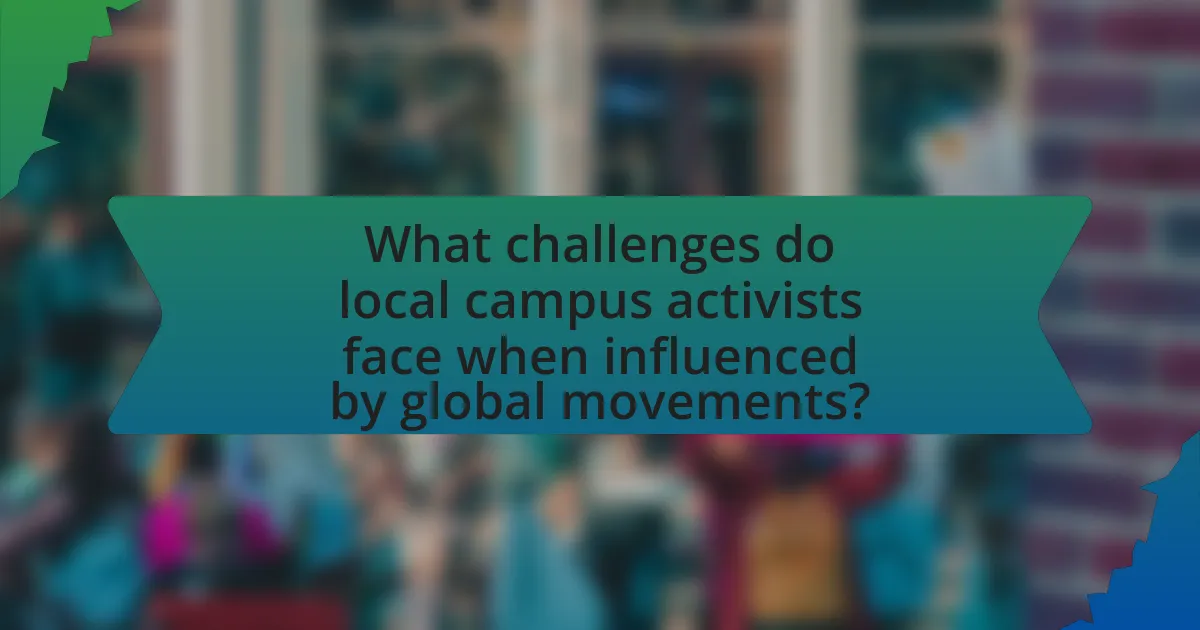
What challenges do local campus activists face when influenced by global movements?
Local campus activists face challenges such as resource allocation, cultural misalignment, and the risk of co-optation when influenced by global movements. Resource allocation issues arise as local activists may struggle to secure funding and support that aligns with broader global agendas, which can divert attention from local needs. Cultural misalignment occurs when global movements do not resonate with the specific social, political, or cultural contexts of the campus community, leading to ineffective activism. Additionally, the risk of co-optation can undermine local initiatives, as global movements may overshadow or appropriate local voices and issues, diluting their impact. These challenges highlight the complexities of integrating global influences into local activism effectively.
How do differing cultural contexts affect the implementation of global strategies?
Differing cultural contexts significantly affect the implementation of global strategies by influencing how organizations adapt their approaches to align with local values, beliefs, and practices. For instance, a global marketing strategy that works in a Western context may fail in an Asian market due to differing cultural norms regarding communication and consumer behavior. Research by Hofstede identifies six dimensions of culture, such as individualism versus collectivism, which can dictate how strategies are perceived and executed. In collectivist cultures, strategies emphasizing community and group benefits are more effective, while individualistic cultures may respond better to personal achievement narratives. This cultural adaptability is crucial for successful strategy implementation, as evidenced by companies like McDonald’s, which tailor their menus to local tastes and preferences, thereby enhancing their global presence while respecting cultural differences.
What are the potential conflicts between global and local priorities?
Potential conflicts between global and local priorities arise when global initiatives do not align with the specific needs and contexts of local communities. For instance, a global movement advocating for environmental sustainability may push for policies that prioritize renewable energy sources, which could conflict with a local community’s reliance on fossil fuels for economic stability. Additionally, global health campaigns may focus on widespread vaccination efforts that overlook local cultural beliefs and practices, leading to resistance and mistrust among local populations. These conflicts highlight the necessity for tailored approaches that consider local circumstances while addressing global issues.
How can activists navigate these cultural differences effectively?
Activists can navigate cultural differences effectively by employing cultural competency strategies, which involve understanding and respecting diverse cultural backgrounds. This approach is essential as it fosters inclusive dialogue and collaboration among activists from various cultural contexts. Research indicates that cultural competency enhances communication and reduces misunderstandings, leading to more effective activism. For instance, a study published in the Journal of Cross-Cultural Psychology highlights that culturally aware activists are better equipped to engage with local communities, resulting in increased support for their initiatives. By prioritizing cultural awareness, activists can build stronger coalitions and adapt their strategies to resonate with different audiences.
What resistance might local activists encounter from institutions?
Local activists may encounter resistance from institutions in the form of bureaucratic obstacles, lack of funding, and institutional policies that prioritize stability over change. Bureaucratic obstacles can manifest as lengthy approval processes for events or initiatives, which can hinder timely action. Additionally, institutions may restrict funding for activist activities, citing budget constraints or misalignment with institutional goals. Policies that discourage dissent or promote a culture of compliance can further stifle local activism, as seen in various universities where administrations have limited student protests or demonstrations to maintain campus order. These forms of resistance can significantly impede the efforts of local activists seeking to effect change.
How do universities respond to global movements on campus?
Universities respond to global movements on campus by implementing policy changes, fostering dialogue, and supporting student-led initiatives. For instance, in response to the Black Lives Matter movement, many universities have adopted diversity and inclusion policies, established task forces, and increased funding for programs that promote racial equity. Additionally, universities often host forums and workshops to engage students in discussions about social justice issues, reflecting their commitment to addressing the concerns raised by these global movements. This proactive approach not only aligns with the values of the student body but also enhances the institution’s reputation as a socially responsible entity.
What strategies can activists use to overcome institutional resistance?
Activists can overcome institutional resistance by employing strategies such as coalition-building, leveraging social media, and utilizing data-driven advocacy. Coalition-building allows activists to unite diverse groups, amplifying their collective voice and increasing pressure on institutions. For example, the Black Lives Matter movement has successfully formed coalitions with various organizations to address systemic racism, demonstrating the power of unified efforts. Leveraging social media enables activists to reach a broader audience, mobilize support, and raise awareness quickly; the #MeToo movement exemplifies this by using platforms to share personal stories and create a global dialogue on sexual harassment. Additionally, utilizing data-driven advocacy involves presenting concrete evidence and statistics to support claims, making it harder for institutions to dismiss demands; for instance, studies showing the impact of climate change have bolstered environmental activism, leading to policy changes in various institutions. These strategies collectively enhance the effectiveness of activism in the face of institutional resistance.
What best practices can local campus activists adopt from global movements?
Local campus activists can adopt the best practice of leveraging social media for mobilization and awareness from global movements. This approach has been effectively utilized by movements like Black Lives Matter and Fridays for Future, which have harnessed platforms such as Twitter and Instagram to reach a wider audience and galvanize support. For instance, the #MeToo movement gained significant traction through social media, demonstrating its power in amplifying voices and creating a sense of community among activists. By employing similar strategies, local campus activists can enhance their outreach, engage more participants, and foster solidarity within their causes.
How can local activists effectively adapt global strategies to their context?
Local activists can effectively adapt global strategies to their context by analyzing local needs and cultural dynamics while integrating successful elements from global movements. This involves assessing the specific social, political, and economic conditions of their community, which allows activists to tailor global strategies to resonate with local audiences. For instance, the Black Lives Matter movement has inspired local campaigns worldwide by emphasizing racial justice, yet local activists have adapted its messaging to address specific issues relevant to their communities, such as police violence or systemic inequality. This contextual adaptation ensures that global strategies are not merely replicated but are transformed to meet the unique challenges faced by local populations, thereby enhancing their effectiveness and relevance.
What lessons can be learned from successful global movements?
Successful global movements demonstrate the importance of unity and clear messaging in achieving social change. For instance, the global climate strikes led by youth activists like Greta Thunberg mobilized millions by emphasizing a singular, urgent message about climate action. This collective action showcases how a focused narrative can galvanize diverse groups towards a common goal, leading to significant political and social impact, as evidenced by increased climate policies in various countries following these movements. Additionally, successful movements often leverage social media to amplify their reach and engage younger audiences, as seen in the #MeToo movement, which highlighted the power of digital platforms in fostering global solidarity and awareness around issues of sexual harassment and assault.
